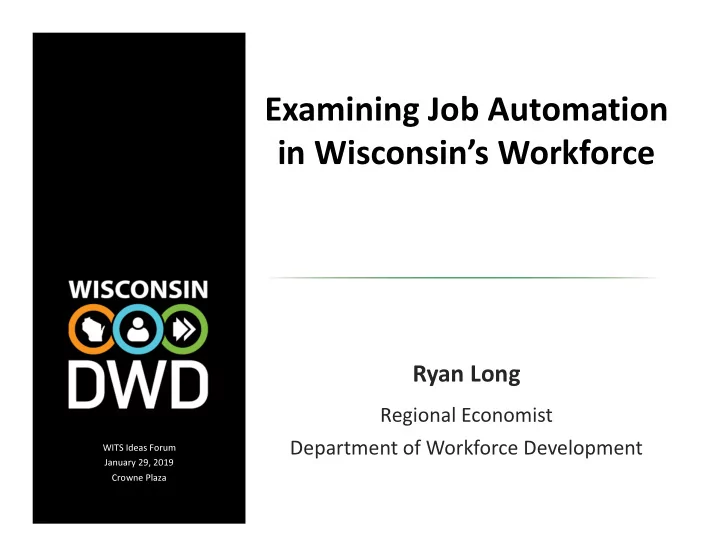

Examining Job Automation in Wisconsin’s Workforce Ryan Long Regional Economist Department of Workforce Development WITS Ideas Forum January 29, 2019 Crowne Plaza
Background "Thou aimest high, Master Lee. Consider thou what the invention could do to my poor subjects. It would assuredly bring to them ruin by depriving them of employment, thus making them beggars.“ Queen Elizabeth I, 1589
Background cont’d “We are being afflicted with a new disease of which some readers may not yet have heard the name, but of which they will hear a great deal in the years to come--namely , technological unemployment . This means unemployment due to our discovery of means of economising the use of labour outrunning the pace at which we can find new uses for labour.” John Maynard Keynes, Economic Possibilities for our Grandchildren, 1930
Background cont’d • This discussion is about potential changes to the current labor market, NOT about job increases in other areas • Two researchers at Oxford estimated the probability that an occupation will become automatable • Three bottlenecks to automation – Perception and Manipulation – Creative Intelligence – Social Intelligence • These bottlenecks corresponded with 9 different O*NET variables
Background cont’d Source : The Future of Employment: How Susceptible are Jobs to Computerisation, C.B. Frey and M.A. Osborne, September 17, 2013, Oxford Martin School, University of Oxford
Methodology • Merged probabilities with OES data to calculate expected value of job automation • Expected Value = 0.23 × 4,280 = 984.4 SOC Code Occupation Probability Employment Expected Value 13-2051 Financial 0.23 4,280 984.4 Analysts
Methodology cont’d • Within each group, the sum of the expected values was divided by total employment to generate the propensity for automation • Propensity = 6,701.2 / 14,410 = 46.5% SOC Code Occupation Probability Employment Expected Value 31-1011 Home Health Aides 0.39 4,750 1,852.5 31-2021 Physical Therapist 0.018 1,640 29.5 Assistants 31-9091 Dental Assistants 0.51 5,860 2,988.6 31-9094 Medical 0.89 1,620 1,441.8 Transcriptionists 31-9095 Pharmacy Aides 0.72 540 388.8 Total 14,410 6,701.2
Propensity for Automation by Occupational Group 100% 90% Food Prep & Serving Sales Farming Production Admin Support 80% Transport & Material Moving Building Maintenance 70% Construction Install, Maint, & Repair 60% Personal Care Financial Operations 50% HC Support Legal Protective 40% 30% Science Math & Comp 20% Arch & Engr Arts Healthcare Pract & Tech Ed & Training Management 10% Social Services 0% 0% 2% 4% 6% 8% 10% 12% 14% 16% Percent of Employment Source : The Future of Employment: How Susceptible are Jobs to Computerisation, C.B. Frey and M.A. Osborne, September 17, 2013, Oxford Martin School, University of Oxford; OES.
Propensity for Automation by Region 70% 65% 60% 55% 50% 45% US WI Southeast Milwaukee WOW Fox Valley Bay Area North Northwest West Western South Southwest Central Central Central Source : The Future of Employment: How Susceptible are Jobs to Computerisation, C.B. Frey and M.A. Osborne, September 17, 2013, Oxford Martin School, University of Oxford; OES.
Propensity for Automation by Typical Educational Requirements 90% 80% 70% 60% 50% 40% 30% 20% 10% 0% No formal educational High school diploma Some college, no Postsecondary non- Associate's degree Bachelor's degree Master's degree Doctoral or credential or equivalent degree degree award professional degree Source : The Future of Employment: How Susceptible are Jobs to Computerisation, C.B. Frey and M.A. Osborne, September 17, 2013, Oxford Martin School, University of Oxford; OES.
Propensity for Automation by Median Hourly Wage 90% 80% 70% 60% 50% 40% 30% 20% 10% 0% Bottom Quintile: $11.55 Second Quintile: $15.34 Third Quintile: $19.13 Fourth Quintile: $28.04 Top Quintile: $99.35 Source : The Future of Employment: How Susceptible are Jobs to Computerisation, C.B. Frey and M.A. Osborne, September 17, 2013, Oxford Martin School, University of Oxford; OES.
Takeaways • Automation exposure is anticipated to continue to increase inequality across different measures of “skill” (education and wages) • However, it might play a role in mitigating the quantity challenge • Adopting a flexible mindset can benefit labor market participants
Questions? Ryan Long Regional Economist 920-448-5268 Ryan.Long@dwd.wisconsin.gov http://dwd.wisconsin.gov
Recommend
More recommend